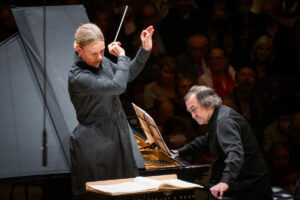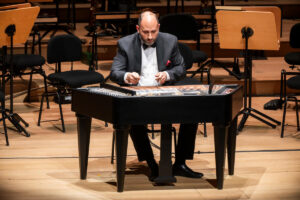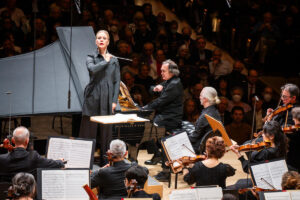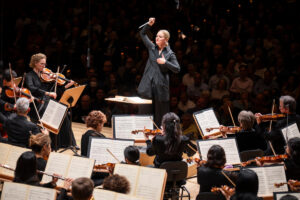
New York Philharmonic, Susanna Mälkki, conductor
Jenõ Lisztes, Cimbalom
David Geffen Hall
November 4, 2023
NEW YORK – Franz Liszt’s Hungarian Rhapsody No. 2 (1851) is such a challenging barnstormer of a piece that one often wonders how ten fingers suffice. On Saturday evening, Jenõ Lisztes, making his New York Philharmonic debut, used two mallets on a cimbalom to realize the rhapsody. His arrangement replicated the work in its entirety, and he played it with extraordinary virtuosity. Liszt was known to improvise a cadenza at the end of the piece, and Lisztes improvised one of his own, improbably one-upping the work proper. The standing ovation that followed was well-earned.

The rest of the concert’s first half was also devoted to music by Hungarian composers. In 1915, Béla Bartôk was fascinated with Romanian folk music, making song gathering trips to the country and incorporating these materials into his own work. Six Romanian Dances was originally written for piano, but in 1917 was scored by Bartôk for string orchestra. Under Susanna Mälkki’s direction, contrasts were played up, with luminescent timbres in the piece’s slow movements and vivacious mixed-meter music in its fast sections. The final dance built towards its close with an urgent-sounding accelerando.

The Philharmonic is celebrating György Ligeti’s centenary with “Ligeti Retrospective.” Rather than a single week devoted to his music, the orchestra has presented single works on programs during the Fall, as well as chamber music concerts and “Nightcap” events. Ligeti’s Piano Concerto (1988) is one of the composer’s most highly regarded later pieces. Soloist Pierre-Laurent Aimard, a contemporary music specialist, has recorded the concerto for DG with Boulez and is its go-to performer. He amply proved this on Saturday, deftly performing the sometimes thorny but always diverting music.
During the 1980s, Ligeti’s musical palette expanded. He explored the polyrhythms of African music and, by extension, minimalist composers such as Steve Reich, who had an interest in Ghanaian drumming. Latin American music was introduced to Ligeti by his student the composer Roberto Sierra. Ligeti’s use of ostinatos is complex, involving overlap of different frameworks and tempos. From Asian music comes pitch material, with scales recalling Gamelan. Alongside these are various other symmetrical divisions of the octave and modal writing. The composer repudiated the idea that his work could easily be categorized as modernist or postmodernist, insisting that the synthesis of elements in a piece like the Piano Concerto evaded being pigeonholed.
Cast in five movements, the concerto’s scoring makes for some tricky entrances, with frequent unison attacks by dissimilar instruments – piano, slapper, and low brass for instance – that could easily go awry. Particularly in the first movement, marked Vivace ritmico e preciso, Mälkki negotiated these interrelations with laser beam accuracy. The second movement has often struck me as overly diffuse, even on Aimard’s DG recording. Here, Mälkki’s navigation of its trajectory and beautiful balancing of its timbres, as well as Aimard’s crystalline gestures, rehabilitated it to be a beguiling standout. The third movement, marked Vivace Cantabile, explores Ligeti’s fascination with polyrhythms, with several layers corruscating around a single line piano melody with its own rhythmic grid. Despite the interplay of ostinatos, it felt more maximalized than minimalist. The fourth movement, in which the texture thins out, vigorous attacks, complete with referee’s whistles and piercing piccolos, still impart the feeling of multiple simultaneous pulsations. One of Aimard’s favorite composers is Messiaen, and, in an example of synergy, the harmony here reflected that composers’ Modes of Limited Transposition. The final presto movement is a great unfurling of the interplay built up in previous sections, with brass solos and shimmering pitched percussion accompanying a gradual ascent of cluster chords in the piano. The cadenza is slow at first, displaying interlocked lines. Upon the orchestra’s return, tension and activity build until a final unison crack closes the piece in midair.
The second half of the concert was devoted to Modest Musorgsky’s Pictures at an Exhibition (1874), in Maurice Ravel’s 1922 orchestration. Much of Ravel’s own orchestral music involved transcribing piano pieces, and his inimitable scoring is exquisite in Pictures. Musorgsky based the piece on paintings by Viktor Hartmann (1834-1873), from an 1874 memorial showing of his work in St. Petersburg.
Pictures’s famous Promenade suggests the peregrination between paintings by a viewer of the exhibition. The four iterations of the Promenade are presented in different scorings. The latter half of the piece dispenses with the Promenade in favor of movements depicting one painting after another. These programmatic pieces are, for the most part, miniatures, but they are chock full of material. The formal freedom with which Musorgsky deploys elements of the music creates unexpected, sometimes startling, juxtapositions. This is abundantly in evidence in the second movement, “Gnomus,” a portentous mixture of multiple themes, first sequentially, then overlapped, and finally given a bellicose valediction. “The Old Castle,” with its suave woodwind solos, has a folk-like melody with off-kilter phrasing and a varied accompaniment. “Bydlo” is a showcase for French horn with snippets of the Promenade melody interspersed with new material. A countermelody soars in the strings. Its climax is filled with thunderous timpani and strings in octaves, after which the music recedes to the accompanied horn solo. “Samuel Goldberg und Schmuỹle” is built with a yearning melody imitative of synagogue music, awe-inspiring in its low-strings presentation. The middle section quickens to a relentless woodwind counter-melody, ultimately joined with the string tune in counterpoint, followed by an emphatic close.
Musorgsky had a playful side as well, which is displayed by the movements “Tuileries Gardens” and “Ballad of the Unhatched Chicks.” Graceful moments populate the opening of “The Market at Limoges.”

The last movements provide a buildup to the much-anticipated finale. “Catacombae (Sepulchrum Romanum)” features stentorian brass chorales, “Cum Mortuis in Lingua Mortua” is an ominous reworking of the Promenade material, which transforms into a particularly Ravellian denouement of pianissimo strings and a gentle, angelic flute solo. It is interrupted in brash fashion by “The Hut on Chicken’s Legs.” In its outer sections there is a chromatic tune, folk dance ostinatos, and emphatic tutti brass passages in full cry, with mysterious pianissimo passages in between. The movement is followed attacca by “The Great Gate at Kiev,” a tour-de-force for symphony orchestra that is a glorious conclusion.
The NY Philharmonic truly sounded glorious itself, enjoying the improved sonics of David Geffen Hall and Mälkki’s assured leadership. The conductor’s gestures were clear and often more characterful than in other pieces on the program. For example, she animated “Gnomus” with incantatory motions, elicited an emotive cast from the theme in “Samuel Goldberg und Schmuỹle,” and lead the finale with broad gestures, ending with her arms closing in a near embrace. The Philharmonic responded with committed, enthusiastic playing that crafted a superlative rendition of Pictures at an Exhibition. I would wager that Mälkki would be welcomed by the orchestra anytime she visits. The audience too.
-Christian Carey
